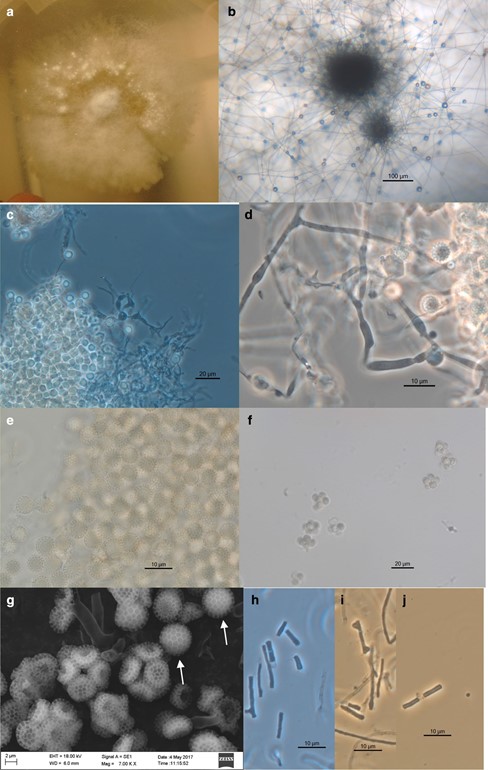Canomyces reticulatus Rahul Sharma & Shouche so. nov.
MycoBank number: MB 829250; Index Fungorum number: IF 829250; Facesoffungi number: FoF 13279;
Genbank MK340501 (ITS), MK340502 (LSU), MK340503 (SSU) (Figs. 8 and 9)
Etymology Reticulatus—referring to the punctate- reticulate ascospores of the fungus.
Description Ascomata discrete, globose, pale cream, 300–450 lm diam. Peridial hyphae undifferentiated from vegetative hyphae, smooth walled, 1.2–3.6 lm wide. Asci globose pale brown 13–16.7 lm, 8-spored, evanescent. Ascospores unicellular, yellowish to pale brown, globose, regularly punctate-reticulate, 5.6–6.3 lm diam, mostly 18 puncta seen from surface view, 0.8–0.9 lm broad.
Asexual Morph Narrow elongate arthroconidia.
Cultures Colonies after 4 week at 28 °C on SDA (5.4–5.5 cm) circular, white, cottony flat, uniform with some sectors with sparse aerial mycelia reverse pale brown fading towards margin; on PDA (4.3 cm) circular, white with sectors having little aerial mycelia giving yellowish brown appearance due to submerged growth, reverse brown at centre fading towards margin; on OA (4.5 cm) circular, snowy white, with irregular patches, flat, reverse cream coloured with central brown spot; on CMA (2.5 cm) grossly circular, lobate, yellowish, sparse aerial mycelia with irregular rings, reverse pale brown with dark centre. At 37 °C after 16 days on SDA (2.8 cm) circular, white, cottony, flat with central raised knob, centre pale coloured, rest white, reverse pale brown, growing margin pale yellow.
Type India, Maharashtra, Beed, Pithi, Ascomata developed in soil S393 (hair baited) collected under a tree, 04 June 2016, R. Sharma (MCC H1008-holotype: MCC 1486 = MS393-AVP-cultures-extype).
Substratum Soil
Distribution Known only from type locality Pithi, Beed District, Maharashtra, India.

Fig. 8 Canomyces reticulatus (MCC 1486T). One-month-old colony on OA (a); PDA (b); SDA (c)

Fig. 9 Canomyces reticulatus (MCC 1486T). a Close-up of colony on SDA showing formation of ascomata after 2 months of incubation; b Developing ascomata in between hyphal network on SDA; c, d Peridial hyphae and ascospores; e punctate-reticulate ascospores; f Asci; g Asci and ascospores (most of the ascospores have collapsed due to vacuum pressure except few indicated by arrow; h, j Narrow elongated arthroconidia; i Arthroconidia with swollen ends
